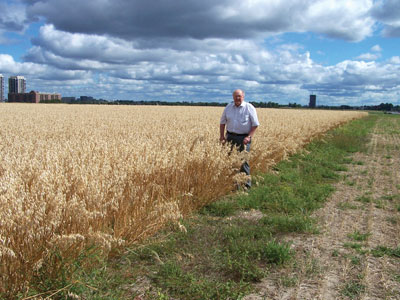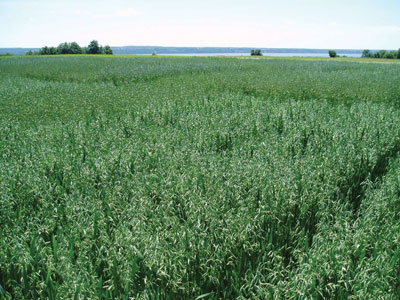
News
Cavena Nuda and Equavena hulless oats win big
Hulless oats are gaining recognition, and some believe it could be the oat crop of the future.
March 2, 2009 By Donna Fleury
Hulless oats are gaining recognition, and some believe it could be the oat crop of the future. Although traditional oat crops still have a place, hulless oat varieties offer a lot of benefits including little processing, and lower storage and transportation costs. Dr. Vernon Burrows, research scientist emeritus with Agriculture and Agri-Food Canada in Ottawa, is continuing his breeding work on improving hulless oats. “We’ve been working for about 15 years to breed off the seed hairs that occurred on our previous hulless oat varieties, and have finally succeeded in developing a naked oat variety,” he says. “Older hulless varieties had a lot of surface borne hairs, known as trichomes, on the groats or true seeds. These hairs were the reason many growers refused to grow them, wanting to avoid the respiratory and itchy effects when they were released into the air during harvest.”
By eliminating the hairs, the bushel weight automatically increases. “Some of the hulless oat test weights are approximating the weights of wheat, which improves storage and transportation efficiency,” explains Burrows. “We’re continuing to try to improve yields and to reduce the variability in other aspects such as plant height, maturity and other agronomic attributes in the lines.”
 |
|
| Dr. Vernon Burrows and his Canadian hulless oats field of dreams. |
In 2008, 12 hulless oat varieties were included in the Manitoba Variety trials including Navan and Baton, both hairy lines as check varieties, other hulless oat varieties and several VAO or value-added lines, all that contain the bald trait. The 2007 trial results were very good, and researchers are expecting similar results from 2008 once the data have been analyzed. One VAO variety, AC Gehl, was registered and released in 2008, and is owned by Wedge Farms Nutrition Inc. of Manitoba and Semican International Inc. of Quebec. This Canadian Naked Oat variety is expected to provide a lot of opportunities for the premium human and high performance horse markets.
Burrows notes that one important aspect of hulless oats is that, like covered seeded oats, are adapted to grow just about everywhere in cereal growing regions, providing the opportunity for growers to grow and feed their own oats locally. Research has shown hulless oats, which have a very good protein content/amino acid profile including lysine, provide a very good diet for pigs and poultry and can easily replace energy from corn and protein from soybeans. “I’ve also been working in China for about 10 years, looking at some of these VAO lines and their potential as a crop particularly in areas where water supply is short and soils are saline,” says Burrows. “The hulless oats can be mixed with rice as an extender, and as an improvement, since the protein of hulless oats is about twice that of rice, plus other nutritional benefits.” Burrows has focused on health aspects including the potential in Celiac diets. Burrows’ research and continued emeritus and volunteer work have opened up new opportunities for Canadian oat farmers and processors in both domestic and international markets.
 |
|
| Plots at St-Augustin in July 2007. Photo courtesy of Nathalie Lanoie, Laval University.
|
Cavena Nuda hulless oats – rice of the PrairiesScott Sigvaldason, president of Wedge Farms Nutrition Inc. at Petersfield, Manitoba, realized the potential of these new naked oat varieties early. In his quest for hulless oat seed and an interest in always trying new crops, Sigvaldason discovered Burrow’s experimental VAO lines about 2000 and began field trials. “The AC Gehl hulless oat variety is unique and the first and only one like it in the world,” explains Sigvaldason. “We are marketing this new Canadian Naked Oat as Cavena Nuda, a premium product for the human food market and ‘rice of the Prairies.’ We’re excited about this completely made-in-Canada variety, and recognize that it is so different from regular oats it has to be presented and marketed in a whole different way. We’re really in the rice business, so we’re not competing against the huge established breakfast cereal companies.”Cavena Nuda cooks and tastes like rice, but the nutritional profile far exceeds rice. It has twice the protein of rice, and very high levels of lysine, an amino acid key to good muscle growth. “Cavena has high beta glucan levels and anti-oxidants for lowering cholesterol, a low glycemic index, making it an excellent option for diabetics and health conscious consumers, and is also proving to be suitable for gluten-free diets for celiac patients.”
Sigvaldason is focussing on specialty markets first, but expects to expand into retail as the market grows. He is working with a distributor and is getting a lot of interest from chefs. “They are interested in the natural, locally grown aspect and a new and different ingredient to bring to their menus,” says Sigvaldason. “We’re taking a slow strategic approach to the market to ensure our success, we don’t want all the instant hype and potential failure that some other new crops have experienced in the past.”
As the market grows, Sigvaldason will be making IP contracts for AC Gehl available to interested growers.
In 2008, Sigvaldason seeded 1200 acres of AC Gehl, which was his highest yielding crop despite some of the most extreme wet weather conditions he has ever experienced. “AC Gehl has an extremely heavy bushel weight, and yielded about 3600 pounds per acre, or the equivalent of a 60 bushel per acre wheat crop,” he says. “This year the crop proved to have great standability, even under excessively wet and windy conditions, the disease resistance in our area is good and the colour and quality were still excellent even after standing in a wet swath until harvest.”
Agronomically, growing hulless oats is the same as for covered oats, except for fertility. Sigvaldason fertilizes hulless oats similar to wheat crops, without any lodging problems. Combining removes all of the hulls and straw, and the natural waxy coating on the grain protects the crop and improves its durability in the field and during storage. “In time, I believe these new hulless oat varieties will be the new oats of the future, something like the transition from industrial rapeseed to canola,” says Sigvaldason.
Sigvaldason has been growing older hulless oat varieties for almost 10 years. “We started growing hulless oats to use in our baby pig rations, because it was difficult to get good quality oat groats,” says Sigvaldason. Sigvaldason built a machine to process the older hulless oat varieties, which is also suitable for covered oats with some modifications. The feed business turned out to be more profitable, so Sigvaldason closed down his hog operation and sold or rented much of his farmland to focus on his feed business in 2006.
Sigvaldason regularly ships about 100 to 120 tonnes of processed covered oat groats per month for the baby pig market.Equavena hulless oats win bigJacques Beauchesne, President of Semican International Inc., a seed company at Plessisville, Quebec, recognized the nutritional benefit of hulless oats for high performance horses and has developed a successful niche market across North America and internationally. Semican acquired a hulless oat breeding line from Dr. Harold Marshall of Pennsylvania (Penn) State University in 2004, which included 30 finished lines, and also has collaborated with Dr. Burrows on some of his hulless oat lines. The 3400acre Semican Research Farm includes 15,000 research testing plots, two full-time cereal breeders and several collaborative projects with leading researchers and agronomists. “Two of our registered hulless varieties are Navaro and Shadow,” says Jacques Beauchesne. “We recently received registration for a third variety, which is to be named Turcotte in honour of Hall of Fame Jockey Ron Turcotte, the spokesman for the thoroughbred world. This new line will have 10 to 11 percent fat content in the grain, which is outstanding for any performance horse that requires a huge amount of energy.”
Hulless oats have a higher fat content than conventional covered oats, and also have higher levels of crude protein, phosphorous and several essential amino acids. “The fat content of regular covered oats varies from four to five percent, compared to Equavena hulless oat varieties that contain seven to 10 percent fat content, 77 percent higher than ordinary hulled or crimped oats,” explains Beauchesne. Proving that quality feed matters, thoroughbred racehorses fed a diet that included Equavena hulless oats won three of the biggest horse races in North America in 2006, and others such as the RCMP rely on Equavena products for their “musical ride” horses and breeding stock.
Beauchesne has championed the use of hulless oats as a value-added crop for Canada, and in 2007 was awarded the Agriculture and Agri-Food Canada (AAFC) Award of Excellence for Export. Key export markets include the US, Dubai, Ireland and the UK. Semican supplies several racetracks and distributes a full line of horse-related products to over 200 feed stores direct. Although markets take time to develop, Beauchesne believes the future potential for Equavena hulless oats is very good. “We have to carefully plan to balance production and market demand so we can supply products year round, which is a challenge in some years. We do expect to see huge opportunities for contract growers in the future."
|
Research assesses impact of environment and In most naked oat varieties, a few kernels remain covered during |